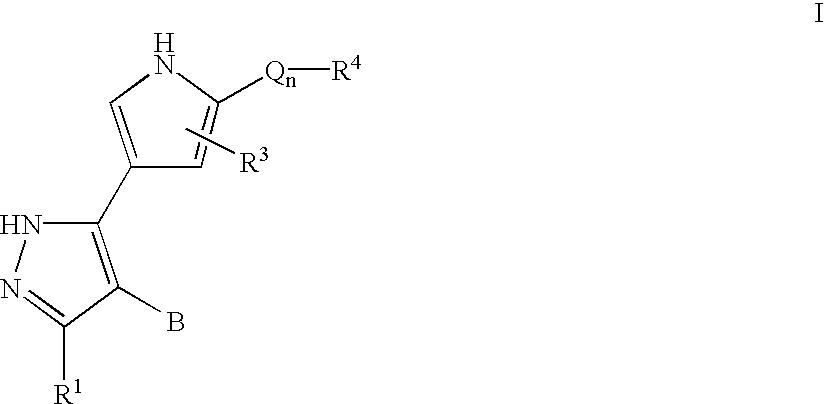Pyrazole-derived kinase inhibitors and uses thereof
a kinase inhibitor and pyrazole technology, applied in the field of medicinal chemistry, can solve the problems of insufficient treatment options and unclear whether these compounds have the appropriate pharmacological profiles to be therapeutically useful, and achieve the effect of inhibiting the activity of the enzyme and preventing the diseas
- Summary
- Abstract
- Description
- Claims
- Application Information
AI Technical Summary
Benefits of technology
Problems solved by technology
Method used
Image
Examples
example 1
(3-Chloro-4-hydroxy-phenyl)-acetic acid methyl ester (3):
To a solution of 3-chloro-4-hydroxyphenyl acetic acid (20 mmol) in methanol (50 mL) was added concentrated HCl solution (5 mL), and stirred for 1 h at 50° C. After excess solvents were removed under vacuum, the residue was dissolved in EtOAc (50 mL) and washed with sat. NaHCO3 solution (2×30 mL), brine (30 mL) and dried over anhydrous Na2SO4. This afforded methyl 3-chloro-4-hydroxy acetate 3 as a colorless oil (4.0 g, 99%). 1H NMR (CDCl3) 6.9-7.0 (d, 1H), 6.8-6.9 (d, 1H), 5.4 (s, 1H), 3.6 (s, 3H), 3.4 (s, 2H).
example 2
(3-Chloro-4-trifluoromethanesulfonyloxy-phenyl)-acetic acid methyl ester (4):
To the methyl ester 3 (4.0 g, 20 mmol) in CH2Cl2 (40 mL) was added TEA (2.8 mL, 20 mmol) and triflic anhydride (3.4 mL, 20 mmol) at 0° C. and stirred for 1 h. The reaction mixture was poured into a solution of saturated NaHCO3 (40 mL) and extracted with EtOAc (3×30 mL). The organic extract was washed with brine and dried over anhydrous MgSO4. After the organic solvents were removed in vacuo, this gave triflate 4 as a brown oil (6.0 g, 18 mmol). HPLC showed a single peak at 12.5 min. 1HNMR (CDCl3) 7.5 (s, 1H), 7.2 (m, 1H), 7.1 (m, 1H), 3.7 (s, 3H), 3.6 (s, 2H).
example 3
(3-Chloro-4-cyano)-acetic acid methyl ester (5):
To a solution of the triflate 4 (6.0 g, 18 mmol) in DMF (10 mL) was added zinc cyanide (2.13 g, 18.2 mmol) and tetrakis(triphenylphosphine) palladium(0) (2.1 g, 1.8 mmol). The resulting mixture was stirred for 15 h at 80° C. and then cooled to room temperature, diluted with EtOAC (50 mL) and poured into a saturated NaHCO3 solution (30 mL). A white precipitate was removed by vacuum filtration. The filtrate was washed with H2O, dried over anhydrous Na2SO4 and concentrated in vacuo. The crude products were purified from Silica Gel chromatography with 20% EtOAc / hexane. This gave methyl 3-chloro-4-cyanophenyl acetate 5 as a white solid (2.7 g, 72%). HPLC showed a single peak at 8.69 min. 1H NMR (CDCl3) 7.7 (d, 1H), 7.5 (s, 1H), 7.3 (d, 1H), 3.7 (s, 3H), 3.6 (s, 2H).
PUM
| Property | Measurement | Unit |
|---|---|---|
| Fraction | aaaaa | aaaaa |
| Fraction | aaaaa | aaaaa |
| Fraction | aaaaa | aaaaa |
Abstract
Description
Claims
Application Information
 Login to View More
Login to View More - R&D
- Intellectual Property
- Life Sciences
- Materials
- Tech Scout
- Unparalleled Data Quality
- Higher Quality Content
- 60% Fewer Hallucinations
Browse by: Latest US Patents, China's latest patents, Technical Efficacy Thesaurus, Application Domain, Technology Topic, Popular Technical Reports.
© 2025 PatSnap. All rights reserved.Legal|Privacy policy|Modern Slavery Act Transparency Statement|Sitemap|About US| Contact US: help@patsnap.com



